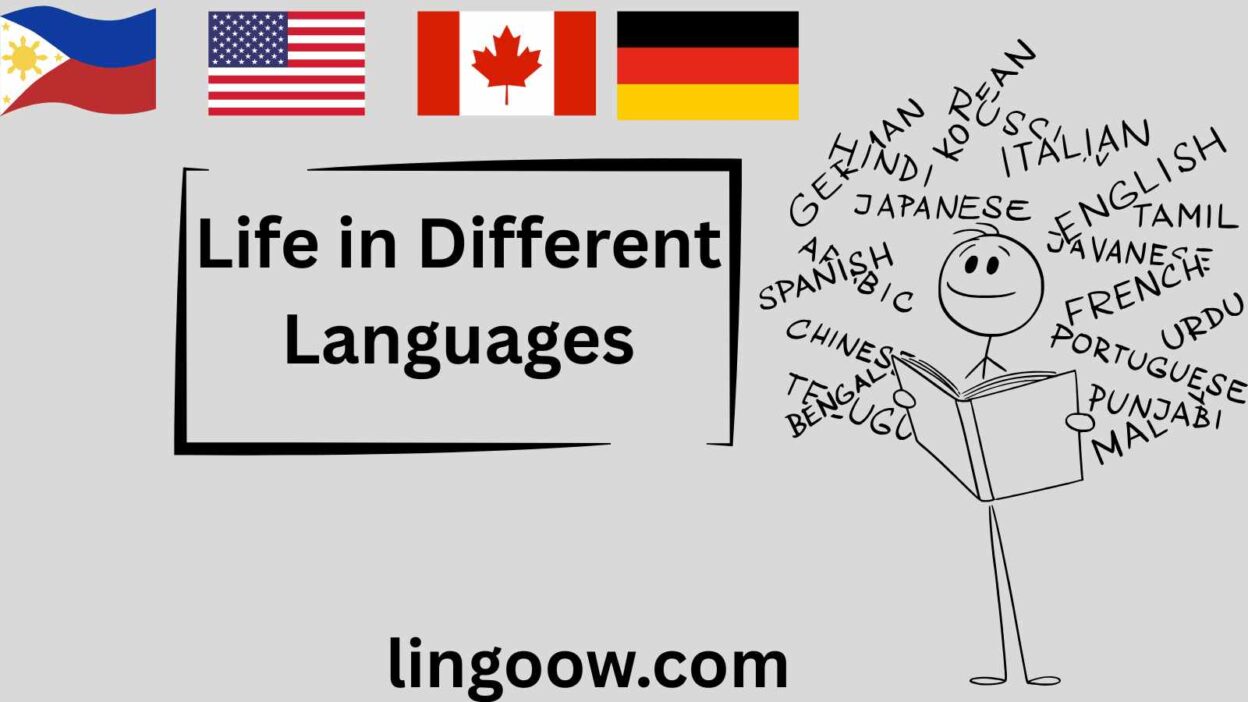The word life carries a weight that transcends borders, a single syllable that holds within it the breath of existence, the pulse of humanity, and the heartbeat of every culture.
I remember sitting with my grandmother years ago, her hands weathered from decades of nurturing, as she spoke of vida—the Spanish word for life—while recounting stories of her childhood in a small village.
Her eyes sparkled as she described the vibrancy of community festivals, the pain of loss, and the quiet joy of everyday moments.
It struck me then how this one word, life, encapsulates so much:
joy, struggle, love, and resilience. Across the globe, every language has its own way of naming this universal experience, yet the essence remains the same—a shared thread weaving humanity together.
In this exploration, we’ll dive into how different cultures express life, uncovering the beauty and diversity of this concept while celebrating its universal power.
Reference Table: The Word for “Life” Across Languages
Below is a table showcasing how the word life is expressed in 15 languages, along with brief cultural or linguistic insights.
| Language | Word/Phrase for Life | Cultural/Linguistic Insight |
| Spanish | Vida | Rooted in Latin vita, it reflects passion and vibrancy in Spanish-speaking cultures. |
| French | Vie | Evokes a poetic sense of existence, often tied to art and philosophy in French culture. |
| German | Leben | A grounded term, tied to the German value of structure and purpose in daily living. |
| Italian | Vita | Linked to la dolce vita (the sweet life), emphasizing beauty and enjoyment. |
| Mandarin Chinese | Shēngmìng (生命) | Combines “birth” and “fate,” reflecting the cyclical and philosophical view of life in China. |
| Hindi | Jīvan (जीवन) | Tied to spiritual growth and the journey of the soul in Indian philosophy. |
| Arabic | Ḥayāh (حياة) | Associated with vitality and divine creation in Islamic culture. |
| Japanese | Jinsei (人生) | Literally “human life,” it emphasizes personal growth and purpose in Japanese culture. |
| Swahili | Maisha | A term that conveys community and shared existence in East African societies. |
| Zulu | Impilo | Reflects health and well-being, central to Zulu communal values. |
| Yoruba | Iye | Linked to destiny and purpose, often spiritual in Yoruba culture. |
| Maori | Ora | Encompasses health, vitality, and spiritual well-being in Maori worldview. |
| Hawaiian | Ola | Signifies life, health, and prosperity, deeply tied to nature in Hawaiian culture. |
| Cherokee | Vnigadvgi | Reflects the interconnectedness of all living things in Cherokee philosophy. |
| Samoan | Ola | Emphasizes communal living and harmony with nature in Samoan culture. |
European Languages
In Europe, the concept of life is woven into languages with rich histories and cultural nuances. In French, vie is more than just existence—it’s a canvas for poetry, art, and existential musings. French literature often portrays life as a fleeting, beautiful journey, as seen in phrases like joie de vivre (joy of living). In Spanish, vida carries a fiery passion, evident in cultural expressions like flamenco or the vibrancy of Latin American festivals. The word stems from Latin vita, a root shared by Italian’s vita, which evokes la dolce vita—the sweet life—celebrating beauty, family, and indulgence. In German, leben is practical yet profound, tied to the structured rhythm of daily existence and the philosophical quest for meaning, as seen in thinkers like Nietzsche. Other European languages, like Portuguese (vida) and Dutch (leven), share similar roots, but their usage reflects local values—Portuguese vida often carries a warm, communal tone, while Dutch leven emphasizes resilience and simplicity.
Asian Languages
Asia’s linguistic diversity offers a kaleidoscope of perspectives on life. In Mandarin Chinese, shēngmìng (生命) combines “birth” and “fate,” reflecting a cyclical view rooted in Confucian and Taoist philosophies. Life is seen as a journey of balance and harmony. In Hindi, jīvan (जीवन) is deeply spiritual, tied to the soul’s journey through reincarnation in Hindu and Jain traditions. Japanese jinsei (人生), meaning “human life,” emphasizes personal growth and the pursuit of ikigai (purpose). In Korean, salm (삶) conveys a grounded sense of existence, often tied to family and perseverance in a rapidly modernizing society. Arabic ḥayāh (حياة), used across more than 20 countries, carries a divine connotation, linking life to God’s gift of creation in Islamic culture. From Thai (chīwit, ชีวิต) to Vietnamese (cuộc sống), Asian languages frame life as a blend of personal struggle, spiritual depth, and communal ties, shaped by centuries of tradition.
African Languages
Africa’s linguistic tapestry reveals how life is celebrated across its diverse cultures. In Swahili, spoken in over 20 East African countries, maisha conveys a collective sense of existence, often tied to community and resilience in the face of challenges. Zulu impilo emphasizes health and well-being, reflecting the communal values of South African societies where life is sustained through mutual support. In Yoruba, spoken in Nigeria and beyond, iye is intertwined with destiny (kadara), highlighting the spiritual journey of the individual within the community. Other African languages, like Amharic (həywät in Ethiopia) and Hausa (rayuwa in Nigeria), similarly tie life to faith, community, and survival. Across Africa, the concept of life often transcends the individual, emphasizing interconnectedness and shared humanity.
Indigenous & Island Languages
Indigenous and island cultures offer unique perspectives on life, deeply rooted in nature and spirituality. In Maori, ora encompasses life, health, and spiritual vitality, reflecting the Maori connection to the land and ancestors. Hawaiian ola similarly ties life to nature, with phrases like ke ola i ka wai (life is in the water) emphasizing environmental harmony. Cherokee vnigadvgi reflects the interconnectedness of all living things, a core tenet of Cherokee philosophy. In Samoan, ola signifies communal living and balance with the natural world, a value shared across Pacific Island cultures. From Inuit (piqatigiit in Nunavut, Canada) to Quechua (kawsay in Peru), these languages, spoken across more than 20 regions, highlight life as a sacred, interconnected force, often tied to the land and ancestral wisdom.
Cultural Insights
The word life has evolved across civilizations, shaped by history, religion, and tradition. In ancient Latin, vita was the root for many European languages, symbolizing not just existence but the essence of being. In Sanskrit, jīva (the root of Hindi jīvan) tied life to the eternal soul, influencing Indian spiritual traditions. In Arabic, ḥayāh reflects Islamic teachings about life as a divine gift, a concept echoed্র
Proverbs
The concept of life inspires proverbs and sayings worldwide, reflecting cultural wisdom:
- Spanish: “La vida es un misterio que hay que vivir, no un problema que hay que resolver.”
(“Life is a mystery to be lived, not a problem to be solved.”)
Emphasizes embracing life’s uncertainties with curiosity. - Chinese: “人生如梦。”
(“Life is like a dream.”)
Reflects the transient, philosophical nature of existence in Chinese thought. - Yoruba: “Bi a ba ni idi, a ni idi lati ma gbe.”
(“As long as there is life, there is hope.”)
Highlights resilience and hope in Yoruba culture. - Maori: “He ora te wakaro, he mate te timatatanga.”
(“The seed of thought brings life, but the beginning of action brings death.”)
Stresses the balance between contemplation and action.
FAQs
Why does the word for life sound similar in many languages?
Many languages share linguistic roots, like Latin vita for European languages or shared cultural influences in regions like the Middle East, where Arabic ḥayāh influences neighboring languages.
What is the oldest known usage of the word life?
The concept appears in ancient texts, like the Sanskrit jīva in the Vedas (circa 1500 BCE) or the Egyptian hieroglyph ankh (symbolizing life, circa 3000 BCE).
How do cultural differences shape the expression of life?
In individualistic cultures, life often emphasizes personal achievement, while collectivist cultures, like those in Africa or Polynesia, focus on community and interconnectedness.
Conclusion
The word life—whether vida, shēngmìng, maisha, or ora—carries the heartbeat of humanity across cultures.
It speaks to our shared experiences of joy, struggle, and connection, while reflecting unique cultural lenses.
From the vibrant passion of Latin America to the spiritual depth of Asia, the communal spirit of Africa, and the nature-bound wisdom of indigenous cultures, life unites us in its universal power.
What does life mean to you? Share your language’s word for life or a personal story in the comments below—let’s celebrate the diversity and unity of this beautiful concept together!




